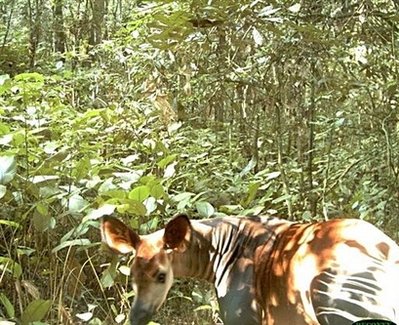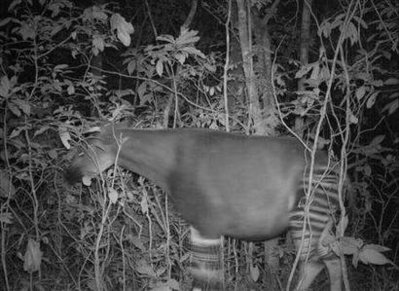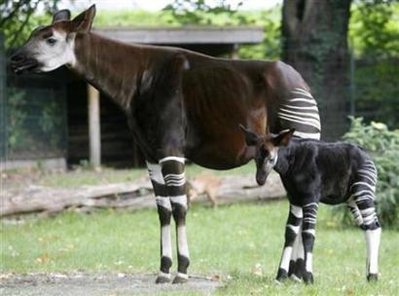tags: Okapi, Okapia johnstoni, camera trap, zoology, rare mammals, Democratic Republic of Congo, Congo rainforest, African Wildlife, Zoological Society of London
This undated image provided by the Zoological Society of London, Thursday, 11 September 2008, shows an okapi, Okapia johnstoni, in Virunga National Park in the Democratic Republic of the Congo proving that the species is still surviving there despite more than one decade of civil conflict. The Zoological Society of London says cameras set up in Congo have snapped the first photos of the rare okapi roaming wild. Okapi have characteristics similar to a deer and a giraffe but is most notable for its zebra-like leg stripes. Zoologists found evidence of an okapi population in the park through tracks a few years ago. Experts say the photos indicate a second group also exists there. The animal previously had only been glimpsed only in passing in the wild, but captive okapis are found in many zoos.
Image: AFP/HO/Zoological Society Of London.
When I was in London, I visited the London Zoo to see the rare okapi, Okapia johnstoni, which has been one of my favorite mammal species since I first learned of its existence when I was a kid. Unfortunately, the zoo's okapi enclosure was undergoing some sort of refurbishment and the okapi were hiding, so I never even caught a glimpse of them. However, even better than seeing captive okapi is seeing them in the rainforests of the Congo, as is being reported today by the Zoological Society of London.
Thierry Lusenge (right), a key member of ZSL's DRC survey team and monitoring officer for ZSL's conservation project in the park, with a ranger. He is showing the ranger how to install the camera trap.
Image: Zoological Society of London.
Using a camera trap, zoologists from the Zoological Society of London and the Congolese Institute for Nature Conservation (ICCN) captured the first ever images of wild okapi, proving that this shy and rare relative of the giraffe has managed to survive war and poaching in the Congo rainforest in the Democratic Republic of the Congo (DRC). The camera trap was set up in the Virunga National Park by the zoological society and conservationists in Congo after okapi tracks were found in the area a few years ago.
"To have captured the first ever photographs of such a charismatic creature is amazing, and particularly special for ZSL given that the species was originally described here over a century ago," stated Noelle Kumpel, a conservationist with the Zoological Society of London. There was one other photograph of an okapi in the wild that scientists previously knew about, she added, but it showed only a leg.
"Okapi are very shy and rare animals -- which is why conventional surveys only tend to record droppings and other signs of their presence."
Okapi droppings look like round pebbles. They are one of the first signs that okapi are not far away.
Image: Zoological Society of London.
The bold stripes on the animal's rump are sometimes referred to as "come follow me stripes," because it is thought they help young animals see their mothers so they can follow through the dense rainforest. Each animal's stripes are unique, like fingerprints.
"The photographs clearly show the stripes on their rear, which act like unique fingerprints. We have already identified three individuals, and further survey work will enable us to estimate population numbers and distribution in and around the Park, which is a critical first step in targeting conservation efforts," added Kumpel.
Okapi stripes are unique and are therefore used like fingerprints to identify individuals.
Image: Zoological Society of London.
Not only has the camera trap provided unequivocal data that can be used to identify individuals, it has enabled zoologists to record new behaviors in these animals.
"We've managed to get pictures of three separate individuals, and we've also got a picture of one roaming around at nighttime and actually foraging, which is the first evidence of this behavior," noted Kumpel. Scientists previously thought okapi fed only during the day, she added.
A nightshot showing the first image of a rare okapi to be photographed in the wild in Congo's Virunga Forest taken 6 August 2008, as released by the Zoological Society of London to Reuters on 11 September 2008.
Image: Zoological Society of London (Handout).
The images indicate that okapi are more widely distributed in the park than was previously thought. For example, these images provide evidence that there is a previously unknown population of okapi on the east side of the Congo River. However, these animals are only found in the Congo rainforest.
Okapi were unknown to European scientists until only one century ago, although early sightings of this animal might have inspired claims of unicorn sightings by Victorian-era explorers. Male okapi have two horns on their foreheads, but when seen from the side, these two horns can look like one.
"Stories came back of this mythical creature and the fact that it might be a unicorn," Kumpel mentioned.
Unfortunately, these mythological "unicorns of Africa" are under threat from poaching by the African bush-meat trade. Virunga National Park is near the Rwanda and Uganda borders, and is still occupied by Congolese and Rwandan rebels, who have hidden in its dense forests for more than a decade and used parts of it as bases to launch attacks.
Besides fighting government forces, these rebels also engage in the bush-meat trade, and okapi meat from the Virunga National Park is now regularly on sale in the nearby town of Beni. The Zoological Society of London survey team warns that if poaching continues, okapi could -- tragically -- become extinct in the Park within a few short years.
The Virunga National Park is also home to a population of endangered moumtain gorillas.
Earlier this year, the Zoological Society used a camera trap to photograph another shy mammal, a pygmy hippopotamus, in Liberia.
Even though okapi are shy and very rare in the wild, there are some animals in zoo breeding programs throughout the world. Below is a picture of a female at the Berlin Zoo accompanied by her two-week-old calf.
A two-week old Okapi stands beside its mother at an enclosure in Berlin Zoo, 5 October 2007.
Image: Arnd Wiegmann (Reuters).
This story is a follow-up on an earlier piece that I wrote: Rare Cousin to the Giraffe Found.
Source
Zoological Society of London press release.
You can help conserve wild okapi
Okapi conservation donations (they also include lots more images of these unusual animals on this site).







Okapi calves are extremely adorable. They look like goat-zebra-hybrids. It's closest relative is really the giraffe?!
It is really sad to think of endangered species as bushmeat.
Becca -- yes, the okapi are the giraffe's closest relatives (except for other giraffes, of course).
RM -- yeah, i agree. it saddens me greatly to see this happening, but the rebels view everything as "supporting" the hated government, so their quest is to destroy everything, even endangered wildlife.